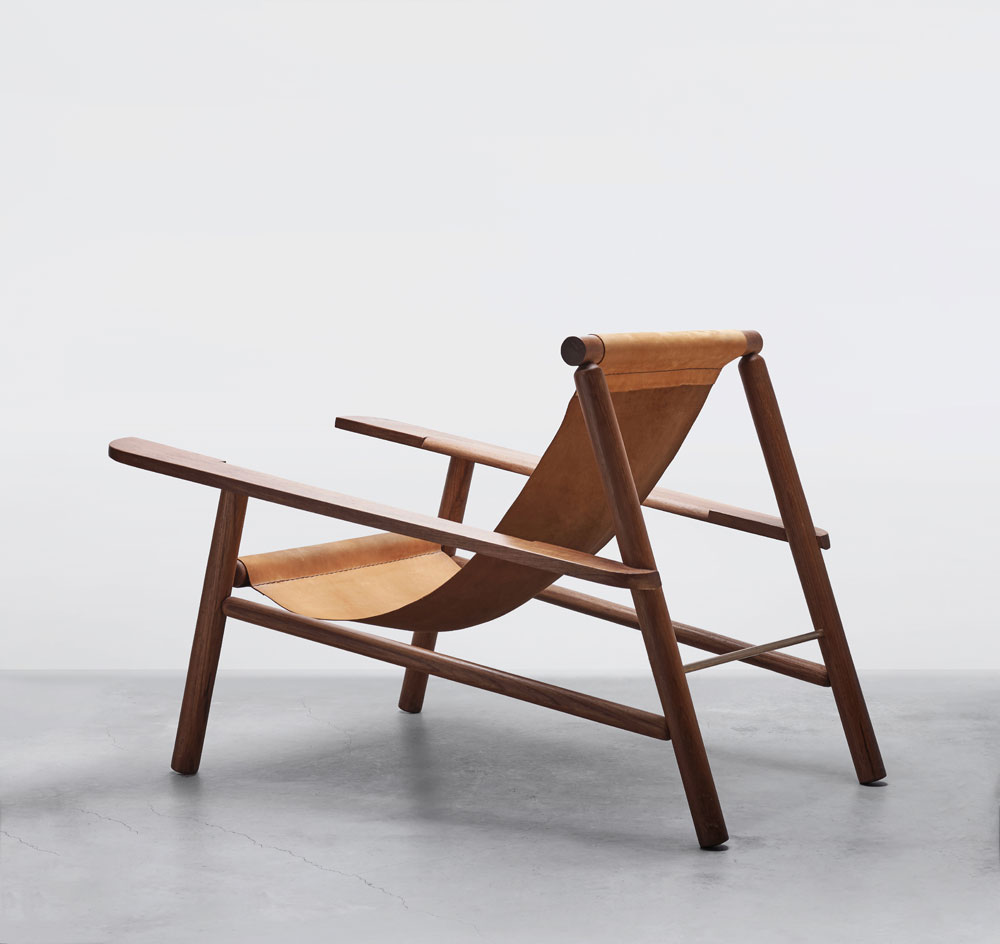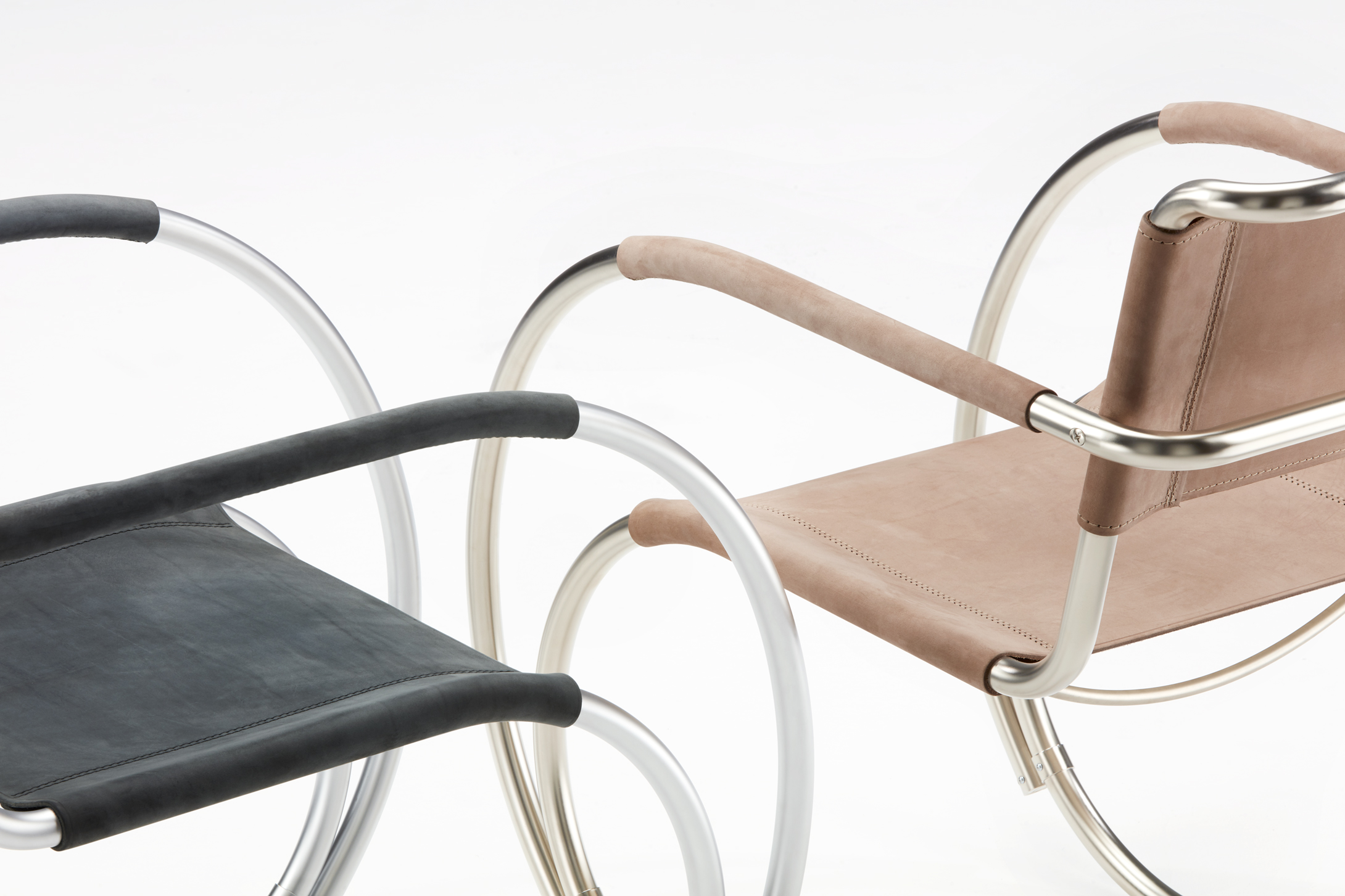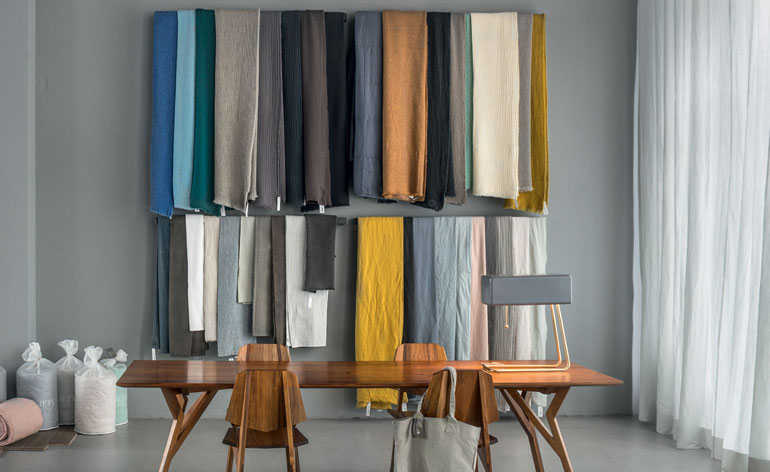Indian tradition marries German rigour in a new cross cultural furniture collection

Pascal Hien and Nikita Bhate first met at Fabrica – a communications research centre near Treviso in Italy – in 2014. Three years later, the two designers present a collaborative project, dubbed ‘Reclaimed Stories’.
A little background context: Hien is a German practitioner concerned with the interstices of user-oriented industrial and artisanal design; while Bhate is a designer interested in creating functional objects relevant to day-to-day life, based in Pune, India. ‘Reclaimed Stories’ combines these remits in an Indian-inspired, handcrafted furniture collection of three armchairs, a sofa and a table.
It’s all objectively beautiful stuff; as solidly practical as it is visually meticulous, imbued with a refined exotic aesthetic that nods to seminal midcentury European design as much as something more wistfully – and willfully – anachronistic.
Take the ‘Tankan/Stroke’ lounge chair. Its fluid curves, shaped by an Indian blacksmith, recall those of the country’s older, heavyweight outdoor iron furniture. But there’s an explicit dualism afforded by the soft, hand-stitched leather upholstery: ‘a simple and bold form,’ the duo states, ‘that conjugates rudimentary and chic’.

'Ayāma' (Extend) deck chair
More evocative still is the retro ‘Āyāma / Extend’ deck chair, made from lathe-turned reclaimed wood and featuring extended arms that can be folded into footrests. The design makes subtle nods to the joinery of traditional Sankheda furniture from Gujarat. The region is similarly referenced in the ‘Sānchā / Block’ dining chair: a simple seat with a granite backrest and a wooden seat featuring a design of almost filigree complexity by blockmakers from the town of Pethapur.
Elsewhere, the ‘Barza / Balcony’ lounge sofa sees a solid teak construction with various seating heights and wide, overhanging arm rests that suggest the canny use of space constraints ubiquitous in everyday Indian life (from ‘balconies of apartments to counter overhangs of the street food stalls’, Bhate and Hien suggest). More elaborate decoration is afforded via the illustrated fabric used to cover the backrest, with Lilliputian depictions of folk stories rendered in natural pigments.
Finally, the ‘Dasta / Handle’ dining table is inspired by traditional cultural eating habits; the slab top of stone marble or glass dotted with holes, into which brass door handles can be inserted to create displays for a diverse selection of cuisines and rituals.
With this collection, Bhate and Hien explain, they sought to explore typical ways of living in India, melding traditional and contemporary design in an ‘expression of the harmonious co-existence in the diverse Indian society’. That philosophy might be lofty, but they’ve as close as succeeded.

The ‘Dasta/Handle’ table is inspired by traditional cultural eating habits

The 'Barzo/Balcony' lounge sofa features a solid teak construction and illustrated fabric covering the backrest
INFORMATION
For more information, visit the Pascal Hien website and the Nikita Bhate website
Wallpaper* Newsletter
Receive our daily digest of inspiration, escapism and design stories from around the world direct to your inbox.
Tom Howells is a London-based food journalist and editor. He’s written for Vogue, Waitrose Food, the Financial Times, The Fence, World of Interiors, Time Out and The Guardian, among others. His new book, An Opinionated Guide to London Wine, will be published by Hoxton Mini Press later this year.
-
 Put these emerging artists on your radar
Put these emerging artists on your radarThis crop of six new talents is poised to shake up the art world. Get to know them now
By Tianna Williams
-
 Dining at Pyrá feels like a Mediterranean kiss on both cheeks
Dining at Pyrá feels like a Mediterranean kiss on both cheeksDesigned by House of Dré, this Lonsdale Road addition dishes up an enticing fusion of Greek and Spanish cooking
By Sofia de la Cruz
-
 Creased, crumpled: S/S 2025 menswear is about clothes that have ‘lived a life’
Creased, crumpled: S/S 2025 menswear is about clothes that have ‘lived a life’The S/S 2025 menswear collections see designers embrace the creased and the crumpled, conjuring a mood of laidback languor that ran through the season – captured here by photographer Steve Harnacke and stylist Nicola Neri for Wallpaper*
By Jack Moss
-
 Tobias Grau’s illuminating solution to home workspace lighting
Tobias Grau’s illuminating solution to home workspace lightingThe German lighting experts launch ‘Team’, a new system featuring innovative technology and a minimal, human-centred design by creative directors Timon and Melchior Grau
By Rosa Bertoli
-
 Thonet’s limited-edition chair by Studio Besau Marguerre celebrates 100 years of Bauhaus
Thonet’s limited-edition chair by Studio Besau Marguerre celebrates 100 years of BauhausBy Harriet Thorpe
-
 Hit list: 5 launches at IMM Cologne to look out for
Hit list: 5 launches at IMM Cologne to look out forKicking off the calendar year of monumental design fairs is IMM Cologne (15-21 January). The German city’s annual event is entering its 69th year, with a host of product releases and inspiring installations from a roster of global players. From ethereal Australian lighting to Danish woven modular benches, here are the new launches we are most looking forward to...
By Sujata Burman
-
 German precision: the ’Mbrace’ rocking chair by Sebastian Herkner for Dedon
German precision: the ’Mbrace’ rocking chair by Sebastian Herkner for DedonBy Catherine Shaw
-
 Slide lines: Bulthaup’s new kitchen offers a movable feast
Slide lines: Bulthaup’s new kitchen offers a movable feastBy Paul McCann
-
 Floor show: Andreas Murkudis’ new Berlin store is dedicated to design and furniture
Floor show: Andreas Murkudis’ new Berlin store is dedicated to design and furnitureBy Nils Binnberg
-
 An art and design exhibition transforms an architectural ruin in Berlin
An art and design exhibition transforms an architectural ruin in BerlinBy Melanie Sevcenko
-
 Plus One Berlin: stay, meet a local, be a Berliner
Plus One Berlin: stay, meet a local, be a BerlinerBy Lauren Ho